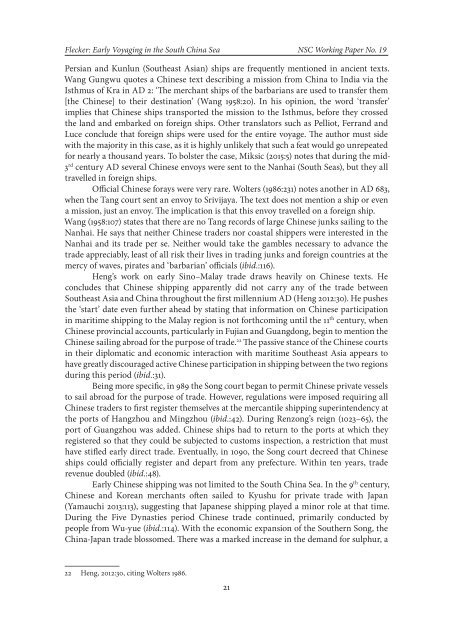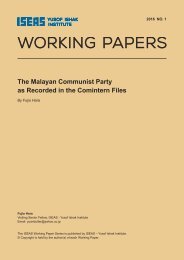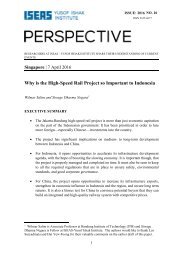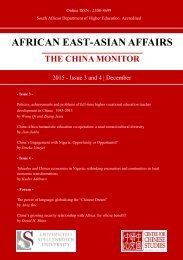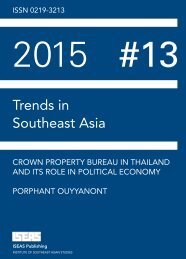NO.19
nscwps19_early_voyaging_south_china_sea_implications_territorial_claims
nscwps19_early_voyaging_south_china_sea_implications_territorial_claims
Create successful ePaper yourself
Turn your PDF publications into a flip-book with our unique Google optimized e-Paper software.
Flecker: Early Voyaging in the South China Sea NSC Working Paper No. 19Persian and Kunlun (Southeast Asian) ships are frequently mentioned in ancient texts.Wang Gungwu quotes a Chinese text describing a mission from China to India via theIsthmus of Kra in AD 2: ‘The merchant ships of the barbarians are used to transfer them[the Chinese] to their destination’ (Wang 1958:20). In his opinion, the word ‘transfer’implies that Chinese ships transported the mission to the Isthmus, before they crossedthe land and embarked on foreign ships. Other translators such as Pelliot, Ferrand andLuce conclude that foreign ships were used for the entire voyage. The author must sidewith the majority in this case, as it is highly unlikely that such a feat would go unrepeatedfor nearly a thousand years. To bolster the case, Miksic (2015:5) notes that during the mid-3 rd century AD several Chinese envoys were sent to the Nanhai (South Seas), but they alltravelled in foreign ships.Official Chinese forays were very rare. Wolters (1986:231) notes another in AD 683,when the Tang court sent an envoy to Srivijaya. The text does not mention a ship or evena mission, just an envoy. The implication is that this envoy travelled on a foreign ship.Wang (1958:107) states that there are no Tang records of large Chinese junks sailing to theNanhai. He says that neither Chinese traders nor coastal shippers were interested in theNanhai and its trade per se. Neither would take the gambles necessary to advance thetrade appreciably, least of all risk their lives in trading junks and foreign countries at themercy of waves, pirates and ‘barbarian’ officials (ibid.:116).Heng’s work on early Sino–Malay trade draws heavily on Chinese texts. Heconcludes that Chinese shipping apparently did not carry any of the trade betweenSoutheast Asia and China throughout the first millennium AD (Heng 2012:30). He pushesthe ‘start’ date even further ahead by stating that information on Chinese participationin maritime shipping to the Malay region is not forthcoming until the 11 th century, whenChinese provincial accounts, particularly in Fujian and Guangdong, begin to mention theChinese sailing abroad for the purpose of trade. 22 The passive stance of the Chinese courtsin their diplomatic and economic interaction with maritime Southeast Asia appears tohave greatly discouraged active Chinese participation in shipping between the two regionsduring this period (ibid.:31).Being more specific, in 989 the Song court began to permit Chinese private vesselsto sail abroad for the purpose of trade. However, regulations were imposed requiring allChinese traders to first register themselves at the mercantile shipping superintendency atthe ports of Hangzhou and Mingzhou (ibid.:42). During Renzong’s reign (1023–65), theport of Guangzhou was added. Chinese ships had to return to the ports at which theyregistered so that they could be subjected to customs inspection, a restriction that musthave stifled early direct trade. Eventually, in 1090, the Song court decreed that Chineseships could officially register and depart from any prefecture. Within ten years, traderevenue doubled (ibid.:48).Early Chinese shipping was not limited to the South China Sea. In the 9 th century,Chinese and Korean merchants often sailed to Kyushu for private trade with Japan(Yamauchi 2013:113), suggesting that Japanese shipping played a minor role at that time.During the Five Dynasties period Chinese trade continued, primarily conducted bypeople from Wu-yue (ibid.:114). With the economic expansion of the Southern Song, theChina-Japan trade blossomed. There was a marked increase in the demand for sulphur, a22 Heng, 2012:30, citing Wolters 1986.21


